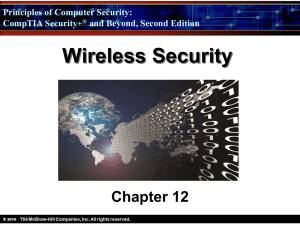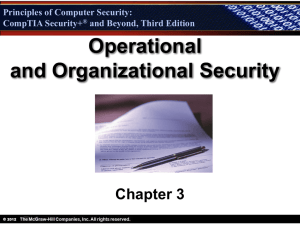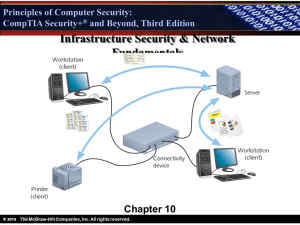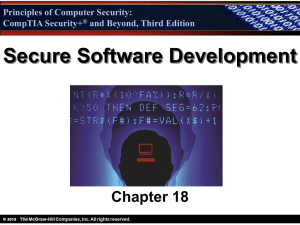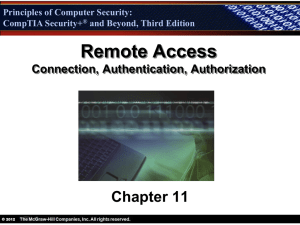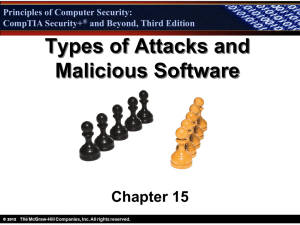Principles of Computer Security
advertisement
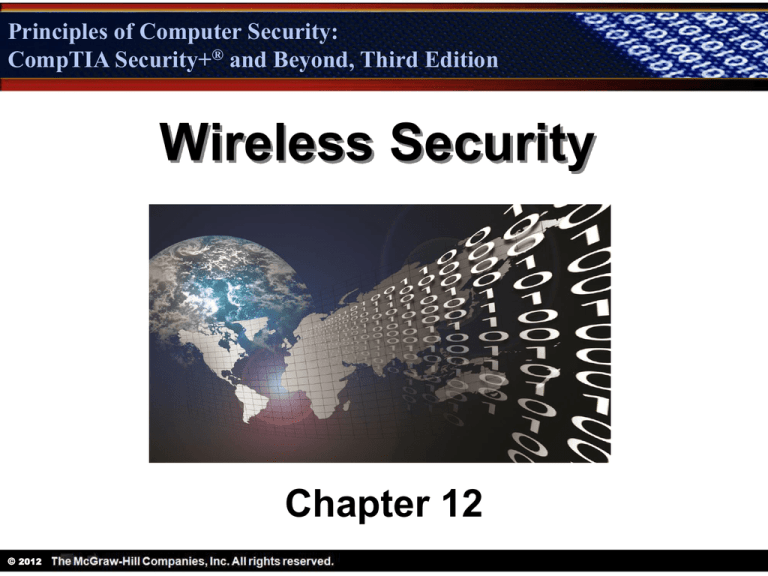
Principles of Computer Security: CompTIA Security+ Security+® and Beyond, Third Edition Wireless Security Chapter 12 © 2012 Principles of Computer Security: CompTIA Security+ Security+® and Beyond, Third Edition Objectives • Describe the different wireless systems in use today. • Identify 802.11’s security issues and possible solutions. © 2012 Principles of Computer Security: CompTIA Security+ Security+® and Beyond, Third Edition Key Terms • • • • • • • • © 2012 2.4 GHz band 5 GHz band Bluejacking Bluesnarfing Bluebugging WEP WPA WPA2 Principles of Computer Security: CompTIA Security+ Security+® and Beyond, Third Edition Introduction to Wireless Networking • Wireless networking is the transmission of packetized data by means of a physical topology that does not use direct physical links. • IEEE 802.11 is a family of protocols that have been standardized by the IEEE for wireless local area networks (LANs). • Wireless Application Protocol (WAP) was one of the pioneers of mobile data applications. • Bluetooth is a short-range wireless protocol typically used on small devices such as mobile phones. © 2012 Principles of Computer Security: CompTIA Security+ Security+® and Beyond, Third Edition Summary Table of the 802.11 Family © 2012 Principles of Computer Security: CompTIA Security+ Security+® and Beyond, Third Edition 3G Mobile Networks • Mobile wireless networks have been or are being upgraded to 3G, greatly enhancing speed and lowering latency. • Increased power and memory of handheld devices also reduces the need for lighter-weight encryption protocols. • The cryptographic standard proposed for 3G is known as KASUMI. • KASUMI is a modified version of the MISTY1 algorithm uses 64-bit blocks and 128-bit keys. © 2012 Principles of Computer Security: CompTIA Security+ Security+® and Beyond, Third Edition Bluetooth • Bluetooth is a short-range (approx. 32 feet), low-power wireless protocol transmitting in the 2.4 GHz band. • Bluetooth transmits data in Personal Area Networks (PANs) through mobile phones, laptops, printers, and audio devices. • Version 1.2 allows speeds up to 721 Kbps and improves resistance to interference over version 1.1. • Bluetooth 2.0 introduced enhanced data rate (EDR), which allows the transmission of up to 3.0 Mbps. © 2012 Principles of Computer Security: CompTIA Security+ Security+® and Beyond, Third Edition Bluetooth Headsets © 2012 Principles of Computer Security: CompTIA Security+ Security+® and Beyond, Third Edition Bluetooth Vulnerabilities • Bluejacking – Term used for the sending of unauthorized messages to another Bluetooth device. • Bluesnarfing – Execution is similar to bluejacking, however with bluesnarfing the attacker copies off the victim’s information, which can include e-mails, contact lists, calendar, etc. • Bluebugging – A far more serious attack than either bluejacking or bluesnarfing. In bluebugging, the attacker uses Bluetooth to establish a serial connection to the device. © 2012 Principles of Computer Security: CompTIA Security+ Security+® and Beyond, Third Edition 802.11 • Group of IEEE standards also called Wi-Fi • The table below shows an overview of each protocol © 2012 Principles of Computer Security: CompTIA Security+ Security+® and Beyond, Third Edition 802.11 Modulation • Direct-sequence spread spectrum (DSSS) is a modulation type that spreads the traffic sent over the entire bandwidth. • Orthogonal frequency division multiplexing (OFDM) multiplexes, or separates, the data to be transmitted into smaller chunks and then transmits the chunks on several subchannels. © 2012 Principles of Computer Security: CompTIA Security+ Security+® and Beyond, Third Edition 802.11 Individual Standards • 802.11a is the wireless networking standard that supports traffic on the 5 GHz band, allowing speeds up to 54 Mbps. • 802.11b protocol provides for multiple-rate Ethernet over 2.4 GHz spread-spectrum wireless. It provides transfer rates of 1 Mbps, 2 Mbps, 5.5 Mbps, and 11 Mbps and uses DSSS. • Features of 802.11b and 802.11a were joined to create 802.11g, 802.11g allows the faster speeds of the 5 GHz specification on the 2.4 GHz band. • 802.11n is on the horizon, with many manufacturers shipping devices based upon the draft specification. 802.11n offers speeds up to 248 Mbps. © 2012 Principles of Computer Security: CompTIA Security+ Security+® and Beyond, Third Edition 802.11 Protocol • Authentication is handled in its most basic form by the 802.11 AP, forcing the clients to perform a handshake when attempting to “associate” to the AP. • Service set identifier (SSID). The SSID setting should limit access only to the authorized users of the wireless network. • Beacon Frame is an 802.11 management frame for the network and contains several different fields, such as the timestamp and beacon interval, but most importantly the SSID. • Wired Equivalent Privacy (WEP) uses the RC4 stream cipher to encrypt the data as it is transmitted through the air. © 2012 Principles of Computer Security: CompTIA Security+ Security+® and Beyond, Third Edition A Common Wireless Router © 2012 Principles of Computer Security: CompTIA Security+ Security+® and Beyond, Third Edition Attacking 802.11 • Wireless is a popular target for several reasons: – – – – – © 2012 Access gained from wireless Lack of default security Wide proliferation of devices Anonymity Low cost Principles of Computer Security: CompTIA Security+ Security+® and Beyond, Third Edition Attacking 802.11 • War-driving is driving around with a wireless locater program recording the number of networks found and their locations. • NetStumbler is a reception-based program that listens to the beacon frames output by other wireless devices. • The network sniffer when combined with a wireless network card it can support, is a powerful attack tool. • Wired Equivalent Privacy (WEP) an encryption protocol that 802.11 uses to attempt to ensure confidentiality of wireless communications. • Site survey an important step in securing a wireless network to avoid sending critical data beyond company walls. • A rogue access point is an unauthorized wireless access point within an organization. © 2012 Principles of Computer Security: CompTIA Security+ Security+® and Beyond, Third Edition Attacking 802.11 (continued) • Service set identifier (SSID) - unique 32-character identifier is attached to the header of the packet • The purpose of beacon frames is to announce the wireless network’s presence and capabilities so that WLAN cards can attempt to associate to it. • MAC address restriction provides limited authentication capability. • WEP encrypts the data traveling across the network with an RC4 stream cipher, attempting to ensure confidentiality. • WEP should not be trusted alone to provide confidentiality. © 2012 Principles of Computer Security: CompTIA Security+ Security+® and Beyond, Third Edition NetStumbler on a Windows PC © 2012 Principles of Computer Security: CompTIA Security+ Security+® and Beyond, Third Edition Windows Displaying Access Points © 2012 Principles of Computer Security: CompTIA Security+ Security+® and Beyond, Third Edition New Security Protocols • Wi-Fi Protected Access (WPA and WPA2 uses 802.1X to provide authentication and uses Advanced Encryption Standard (AES) as the encryption protocol. • Temporal Key Integrity Protocol (TKIP) overcomes the WEP key weakness, as a key is used on only one packet. • 802.1X protocol supports a wide variety of authentication methods and also fits well into existing authentication systems such as RADIUS and LDAP. © 2012 Principles of Computer Security: CompTIA Security+ Security+® and Beyond, Third Edition Implementing 802.X • Three common methods are used to implement 802.1X: EAP-TLS, EAPTTLS, and EAP-MD5. • EAP-TLS relies on TLS, an attempt to standardize the SSL structure to pass credentials. • EAP–Tunneled TLS Protocol (EAPTTLS) – based on EAP-TLS, but allows the use of legacy authentication protocols such as Password Authentication Protocol (PAP), Challenge-Handshake Authentication Protocol (CHAP), MS-CHAP, or MS-CHAP-V2. • EAP-MD5 - does improve the authentication of the client to the AP, but does little else to improve the security of your AP. • The use of encryption should always be employed, typically with WPA or WPA2. Turing off SSID broadcasting can help avoid some scanning. Additionally, regular site surveys will help avoid rogue access points. © 2012 Principles of Computer Security: CompTIA Security+ Security+® and Beyond, Third Edition Chapter Summary • Describe the different wireless systems in use today. • Detail WAP and its security implications. • Identify 802.11’s security issues and possible solutions. © 2012



